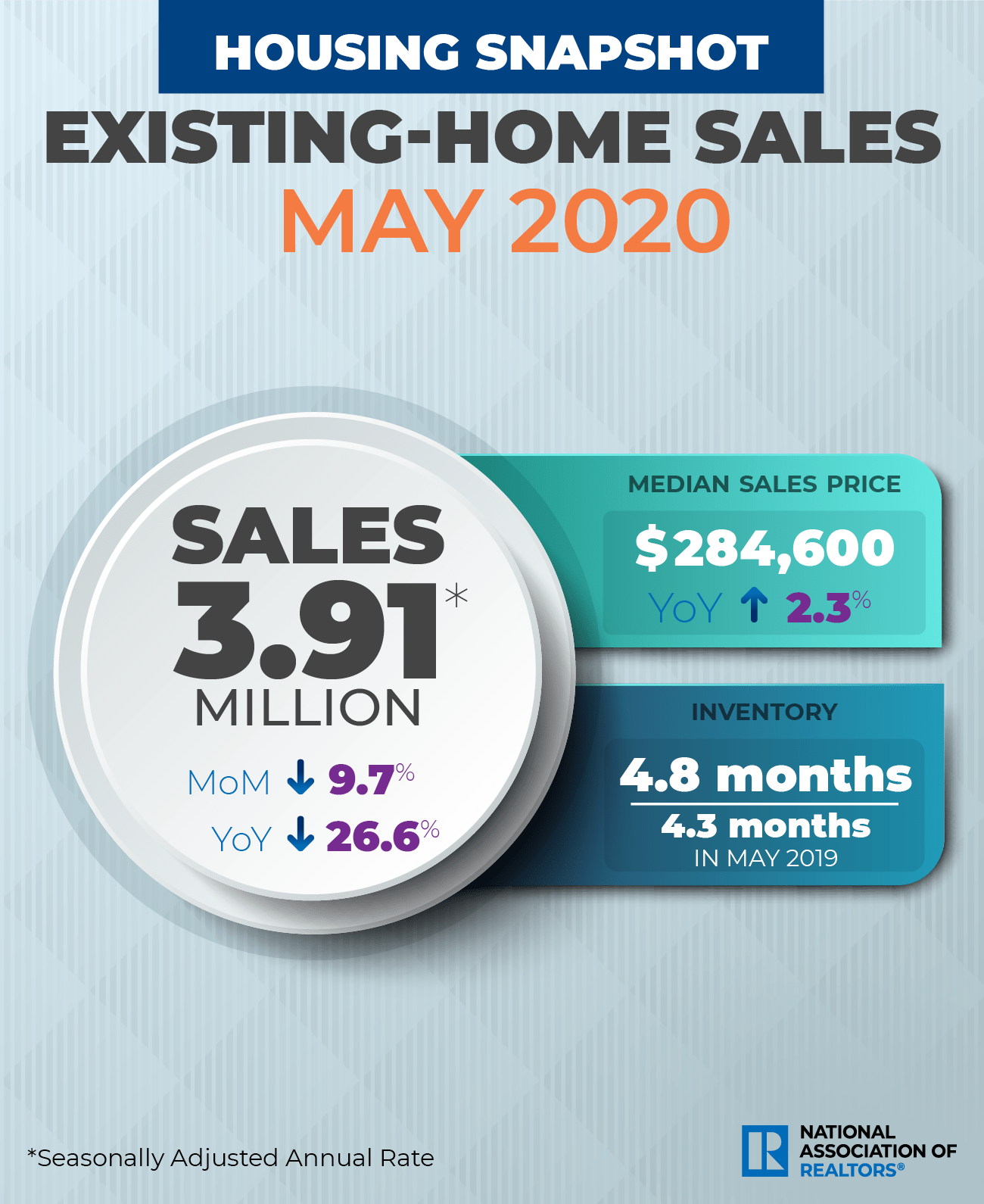Existing-home sales are down 9.7 percent from April to a seasonally adjusted rate of 3.91 million, according to the latest data from the National Association of REALTORS® (NAR). The dip marks three consecutive months of declines in sales as a result of the coronavirus pandemic, and a 26.6 percent drop from May 2019. All four major regions experienced a decreased in sales, but the Northeast saw the biggest month-over-month drop.
For all housing types, the median existing-home price in May was $284,600, a 2.3 percent increase YoY. In terms of inventory, the end of May recorded 1.55 million units—a 6.2 percent increase from April but 18.8 percent lower YoY. Unsold inventory currently sits at a 4.8-month supply—an increase from 4.0 months in April and 4.3 months in May 2019.
Single-family sales were down 9.4 percent in May to 3.57 million, and down 24.8 percent YoY. The median price was $287,700—an increase of 2.4 percent from May 2019. Existing condos and co-op sales dropped 12.8 percent in May to 340,000, and decreased 41.4 percent from a year ago. The median price was $252,300 in May, a 1.6 percent decrease YoY.
By Region:
Midwest
Existing-Home Sales: 990,000 (-20.2%YoY)
Median Price: $227,400 (+3.0%YoY)
Northeast
Existing-Home Sales: 470,000 (-29.9% YoY)
Median Price: $327,900 (+7.8%YoY)
South
Existing-Home Sales: 1.73 million (-25.1% YoY)
Median Price: $247,400 (+2.1%YoY)
West
Existing-Home Sales: 720,000 (-35.1% YoY)
Median Price: $408,400 (-0.2% YoY)
How the Industry Is Responding:
“Sales completed in May reflect contract signings in March and April—during the strictest times of the pandemic lockdown and hence the cyclical low point. Home sales will surely rise in the upcoming months with the economy reopening, and could even surpass one-year-ago figures in the second half of the year. New home construction needs to robustly ramp up in order to meet rising housing demand. Otherwise, home prices will rise too fast and hinder first-time buyers, even at a time of record-low mortgage rates. Properties typically remained on the market for 26 days in May, seasonally down from 27 days in April, but equal to 26 days in May 2019. Fifty-eight percent of homes sold in May 2020 were on the market for less than a month. Relatively better performance of single-family homes in relation to multifamily condominium properties clearly suggest migration from the city centers to the suburbs. After witnessing several consecutive years of urban revival, the new trend looks to be in the suburbs as more companies allow greater flexibility to work from home.” — Lawrence Yun, Chief Economist, NAR
“Although the real estate industry faced some very challenging circumstances over the last several months, we’re seeing signs of improvement and growth, and I’m hopeful the worst is behind us. NAR, along with our partners and 1.4 million members, are already working to reignite America’s real estate industry, which will be a key driver in our nation’s economic recovery.” — Vince Malta, President, NAR
“Consumers were hesitant to venture out and look for a new home in May, even as stay-at-home orders were being lifted. It seems the housing market needed more time to recover, while eager buyers waited to regain confidence in the safety of the real estate process and the wellbeing of the economy as a whole. Although May’s decrease seems bleak, there is hope on the horizon shown by rapidly increasing purchase mortgage applications in recent weeks.” — Bill Banfield, Vice President of Capital Markets, Quicken Loans
“The most noteworthy data point in the May existing-home sales report was that existing housing supply last month was down almost 19 percent compared to a year ago. As buyers are returning to the market, as evidenced by the strong, nine-week rebound in MBA’s purchase application data, the lack of homes for sale will be a real constraint. Although demand certainly dropped in March and April due to the crisis, supply dropped even more, and has thus far kept home prices from declining. We expect that home-price growth will pick up over the summer due to insufficient supply levels. The market is supported by strong demand from first-time homebuyers, who represented 34 percent of home purchases in May. Millennial-driven demand will be a tailwind for the market for the next several years.” — Mike Fratantoni, SVP & Chief Economist, Mortgage Bankers Association













